Abstract
Objective:
The purpose of this study was to compare the three dimensional changes of tooth movement using four different types of maxillary molar distalization appliances; pendulum appliance (PD), mini-implant supported pendulum appliance (MPD), stainless steel open coil spring (SP) and mini-implant supported stainless steel open coil spring (MSP).
Methods:
These experiments were performed using the Calorific machineⓇ which can simulate dynamic tooth movement. Computed tomography (CT) images of the experimental model were taken before and after tooth movement in 1 mm thicknesses and reconstructed into a three dimensional model using V-works 4.0TM. These reconstructed images were superimposed using Rapidform 2004TM and the direction and amount of tooth movement were measured.
Results:
The mean reciprocal anchor loss ratio at the first premolar was 17 - 19% for the PD and SP groups. The appliances using mini-implants (MPD or MSP) resulted in less anchorage loss (7 - 8%). On application of a pendulum appliance or MPD, distalization was obtained by tipping rather than by bodily movement. Furthermore, the maxillary second molar tipped distally and bucally. But on application of MSP, distalization was achieved almost by bodily movement.
REFERENCES
1.Gianelly AA., Vaitas AS., Thomas WM., Berger DG. Distalization of molars with repelling magnets. J Clin Orthod. 1988. 22:40–4.
2.Gianelly AA., Vaitas AS., Thomas WM. The use of magnets to move molars distally. Am J Orthod Dentofacial Orthop. 1989. 96:161–7.

3.Hilgers JJ. The pendulum appliance for Class II non-compliance therapy. J Clin Orthod. 1992. 26:706–14.
4.Gianelly AA., Bednar J., Dietz VS. Japanese NiTi coils used to move molars distally. Am J Orthod Dentofacial Orthop. 1991. 99:564–6.

5.Jones RD., White JM. Rapid Class II molar correction with an open-coil jig. J Clin Orthod. 1992. 26:661–4.
6.Carano A., Testa M. The distal jet for upper molar distalization. J Clin Orthod. 1996. 30:374–80.
9.Pieringer M., Droschl H., Permann R. Distalization with a Nance appliance and coil springs. J Clin Orthod. 1997. 31:321–6.
10.Kircelli BH., Pektas ZO., Kircelli C. Maxillary molar distalization with a bone-anchored pendulum appliance. Angle Orthod. 2006. 76:650–9.
11.Chang YJ., Lee HS., Chun YS. Microscrew anchorage for molar intrusion. J Clin Orthod. 2004. 38:325–30.
12.Yun SW., Lim WH., Chun YS. Molar control using indirect miniscrew anchorage. J Clin Orthod. 2005. 39:661–4.
13.Weijs WA., de Jongh HJ. Strain in mandibular alveolar bone during mastication in the rabbit. Arch Oral Biol. 1977. 22:667–75.

14.Burstone CJ., Pryputniewicz RJ. Holographic determination of centers of rotation produced by orthodontic forces. Am J Orthod. 1980. 77:396–409.

15.Caputo AA., Chaconas SJ., Hayashi RK. Photoelastic visualization of orthodontic forces during canine retraction. Am J Orthod. 1974. 65:250–9.

17.Moss ML., Skalak R., Patel H., Sen K., Moss-Salentijn L., Shinozuka M, et al. Finite element method modeling of craniofacial growth. Am J Orthod. 1985. 87:453–72.

18.Ogura M., Yamagata K., Kubota S., Kim JH., Kuroe K., Ito G. Comparison of tooth movements using Friction-Free and preadjusted edgewise bracket systems. J Clin Orthod. 1996. 30:325–30.
19.Drescher D., Bourauel C., Thier M. Application of the orthodontic measurement and simulation system (OMSS) in orthodontics. Eur J Orthod. 1991. 13:169–78.

20.Rhee JN., Chun YS., Row J. A comparison between friction and frictionless mechanics with a new typodont simulation system. Am J Orthod Dentofacial Orthop. 2001. 119:292–9.

21.Chun YS., Row J., Suh MS., Park IK. An experimental study on the dynamic tooth moving effects of two precision lingual archs (Pla) for correction posterior scissor bite by the calorific machine. Korean J Orthod. 1998. 28:29–41.
22.Ghosh J., Nanda RS. Evaluation of an intraoral maxillary molar distalization technique. Am J Orthod Dentofacial Orthop. 1996. 110:639–46.

23.KeleşA. Erverdi N., Sezen S. Bodily distalization of molars with absolute anchorage. Angle Orthod. 2003. 73:471–82.
24.Wehrbein H., Feifel H., Diedrich P. Palatal implant anchorage reinforcement of posterior teeth: a prospective study. Am J Orthod Dentofacial Orthop. 1999. 116:678–86.

25.Carano A., Velo S., Leone P., Siciliani G. Clinical applications of the Miniscrew Anchorage System. J Clin Orthod. 2005. 39:9–24.
26.Deguchi T., Takano-Yamamoto T., Kanomi R., Hartsfield JK Jr., Roberts WE., Garetto LP. The use of small titanium screws for orthodontic anchorage. J Dent Res. 2003. 82:377–81.
27.Sugawara J., Kanzaki R., Takahashi I., Nagasaka H., Nanda R. Distal movement of maxillary molars in nongrowing patients with the skeletal anchorage system. Am J Orthod Dentofacial Orthop. 2006. 129:723–33.

28.Chang HN., Hsiao HY., Tsai CM., Roberts WE. Bone-screw anchorage for pendulum appliances and other fixed mechanics applications. Semin Orthod. 2006. 12:284–9.

29.Byloff FK., Darendeliler MA. Distal molar movement using the pendulum appliance. Part 1: clinical and radiological evaluation. Angle Orthod. 1997. 67:249–60.
30.Bondemark L., Kurol J. Class II correction with magnets and superelastic coils followed by straight-wire mechanotherapy. Occlusal changes during and after dental therapy. J Orofac Orthop. 1998. 59:127–38.
31.Bondemark L., Kurol J., Bernhold M. Repelling magnets versus superelastic nickel-titanium coils in simultaneous distal movement of maxillary first and second molars. Angle Orthod. 1994. 64:189–98.
Fig 1.
Electric diagram of the Calorific MachineⓇ (electrothermodynamic teeth model connected to a heat generating and temperature regulating system).
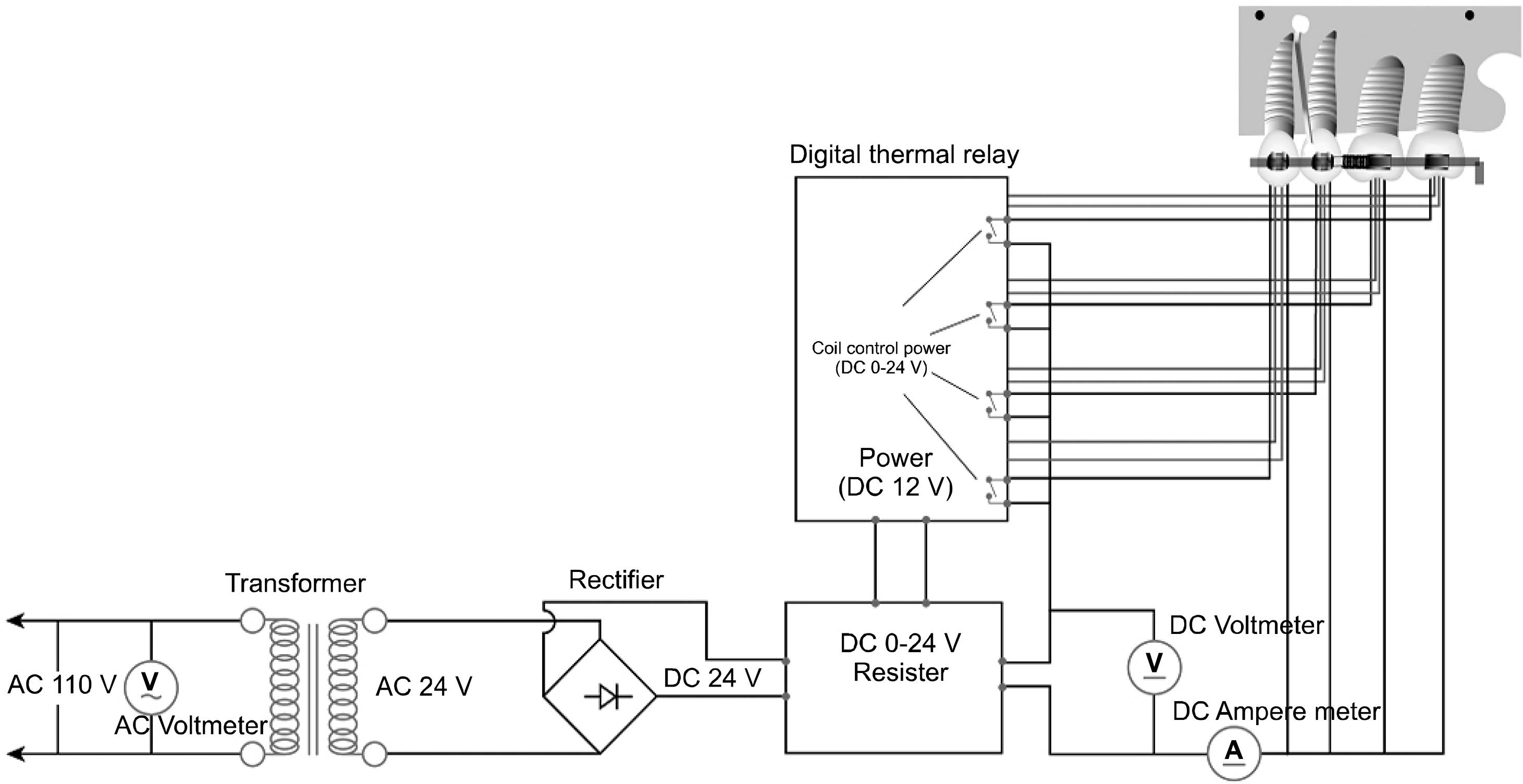
Fig 2.
Experimental set-up model. A, Experimental teeth were placed in the basal bone component. Circle shows one of the metal reference markers used for superimposition; B, sticky wax was built up around roots of the experimental teeth; C, circles were metal balls used for measuring tooth movement.

Fig 3.
Schematic drawings of experimental models. A, Pendulum appliance, PD; B, mini-implant supported pendulum appliance, MPD; C, open-coil spring, SP; D, mini-implant supported open-coil spring, MSP.
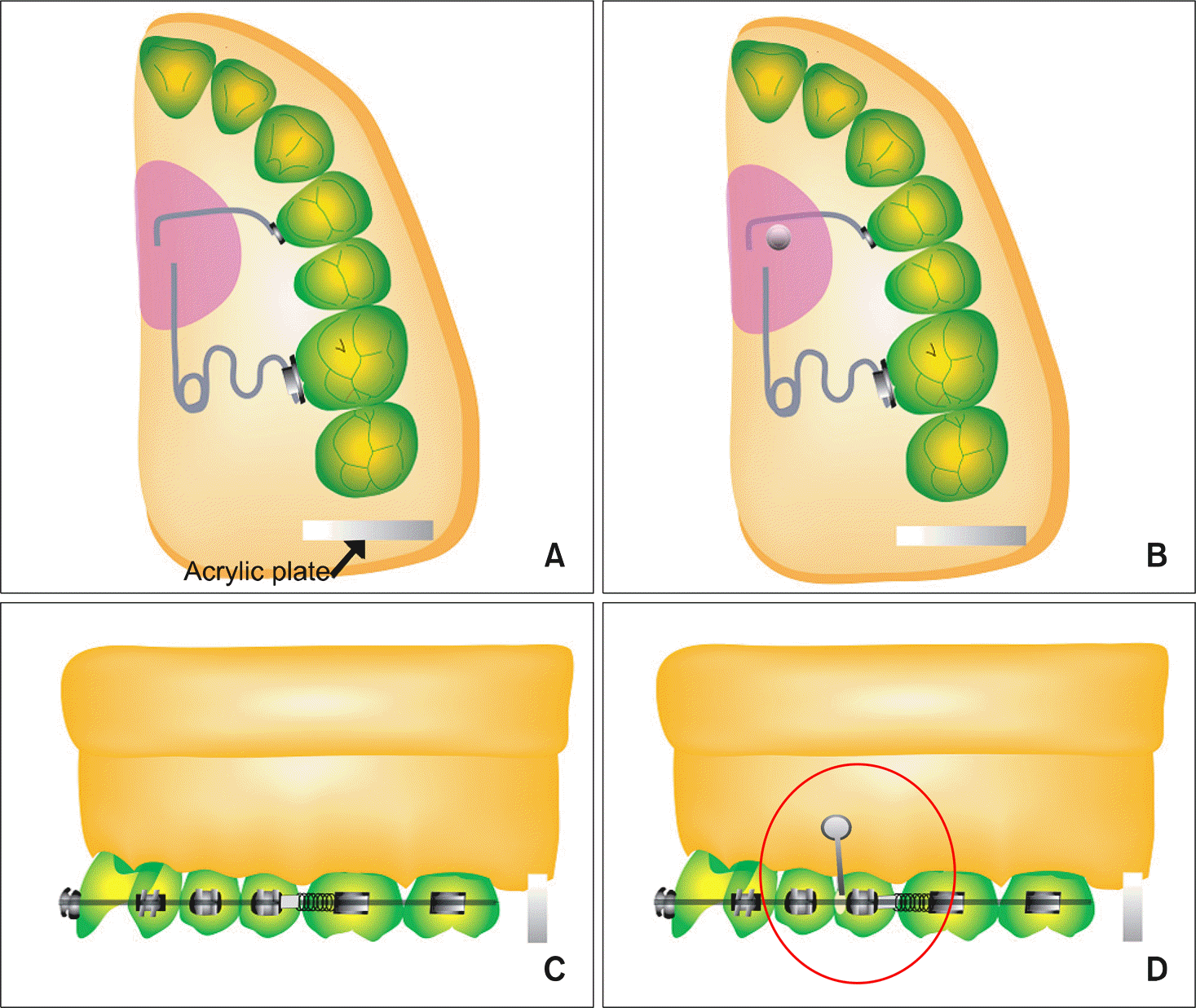
Fig 4.
Superimposition and measurement using Rapidform 2004TM. A, Before tooth movement; B, after tooth movement; C, sagittal view of superimposition before and after experiment. Circle shows one of the reference markers used for superimposition. X axis is the bucco-lingual direction in premolars and molars, and mesio-distal direction in incisors. Y axis is the occluso-gingival direction. Z axis is the mesio-distal direction in premolars and molars, and labiolingual direction in incisors. D, measurement of reference markers are listed in the box.
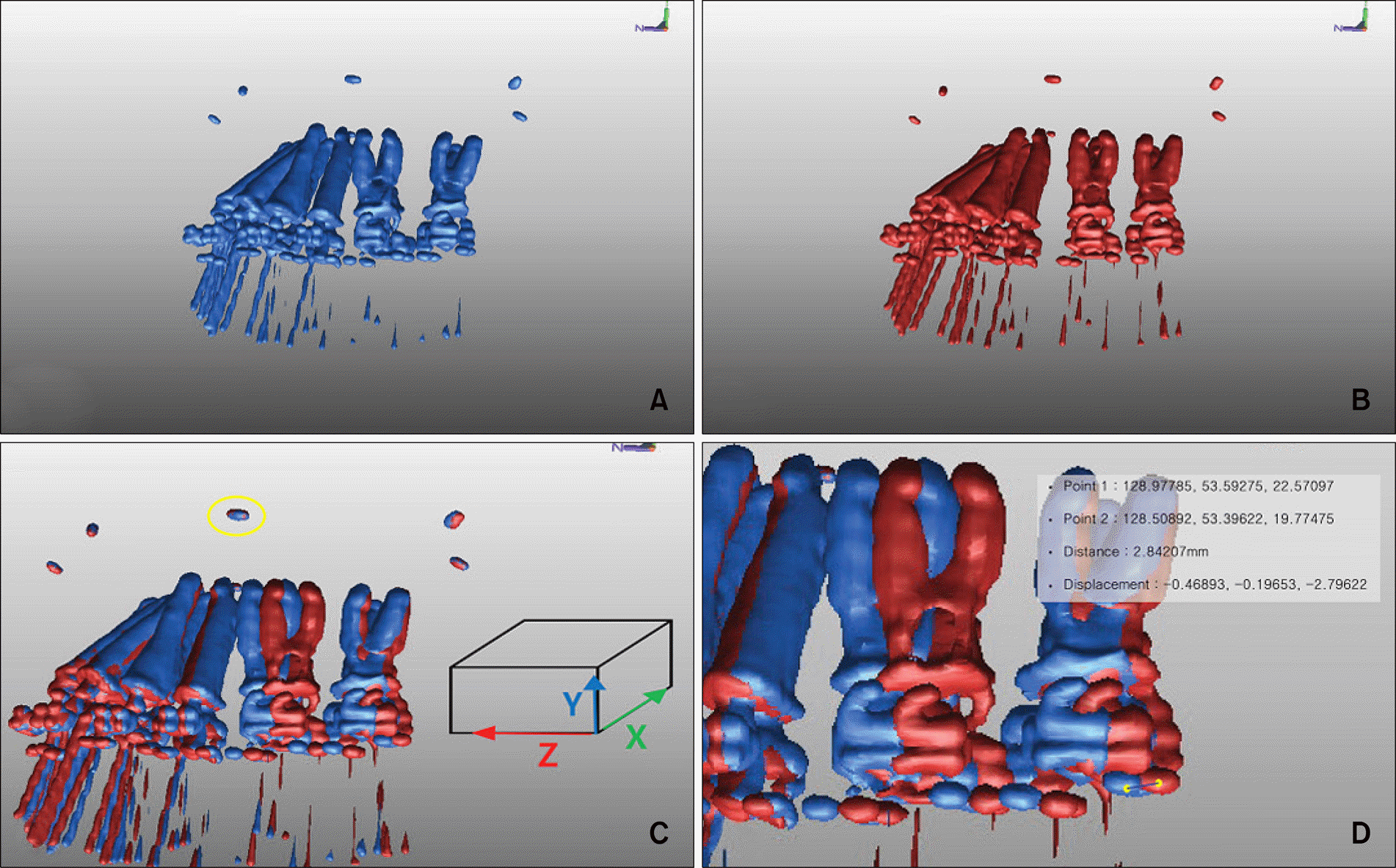
Fig 5.
Comparisons of Z axis displacement of R-MB between four groups on molar tipping. PD, Pendulum appliance; MPD, mini-implant supported pendulum appliance; SP, open-coil spring; MSP, mini-implant supported open-coil spring.
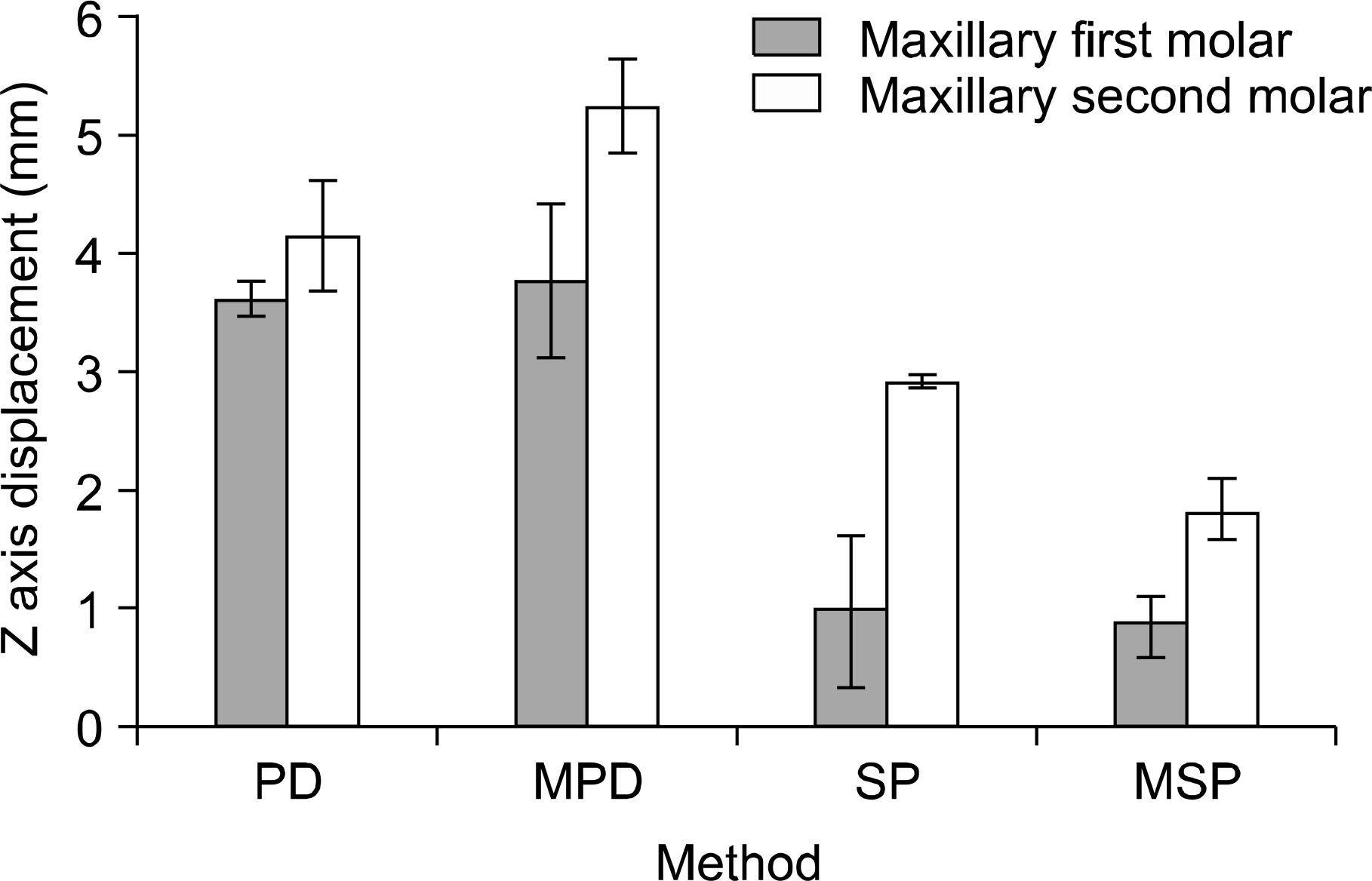
Fig 6.
Comparisons of Y axis displacement of DB-MB between four groups on molar tipping. PD, Pendulum appliance; MPD, mini-implant supported pendulum appliance; SP, open-coil spring; MSP, mini-implant supported open-coil spring.
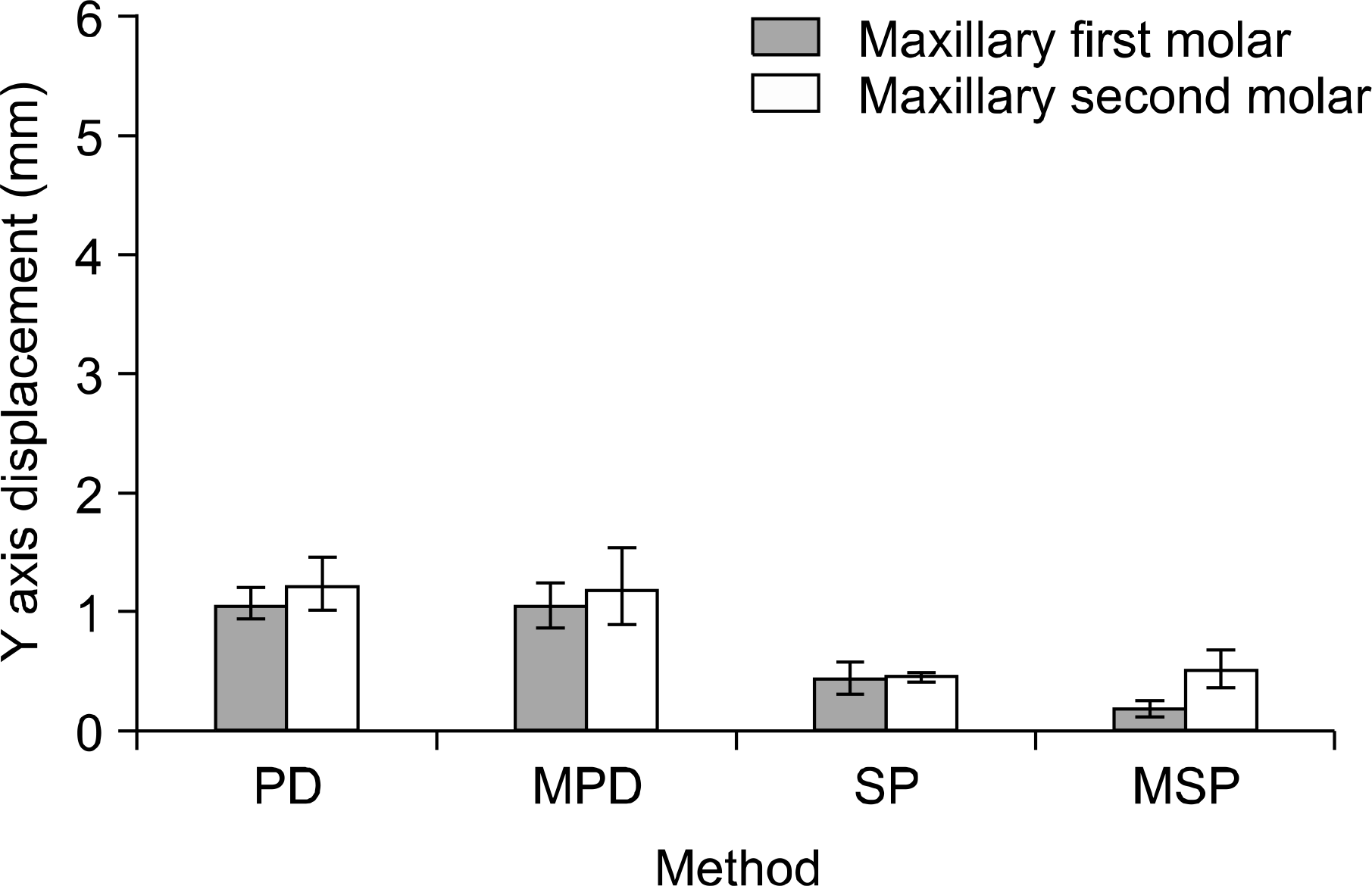
Fig 7.
Comparisons of anchor loss between four groups. PD, Pendulum appliance; MPD, mini-implant supported pendulum appliance; SP, open-coil spring; MSP, mini-implant supported open-coil spring.
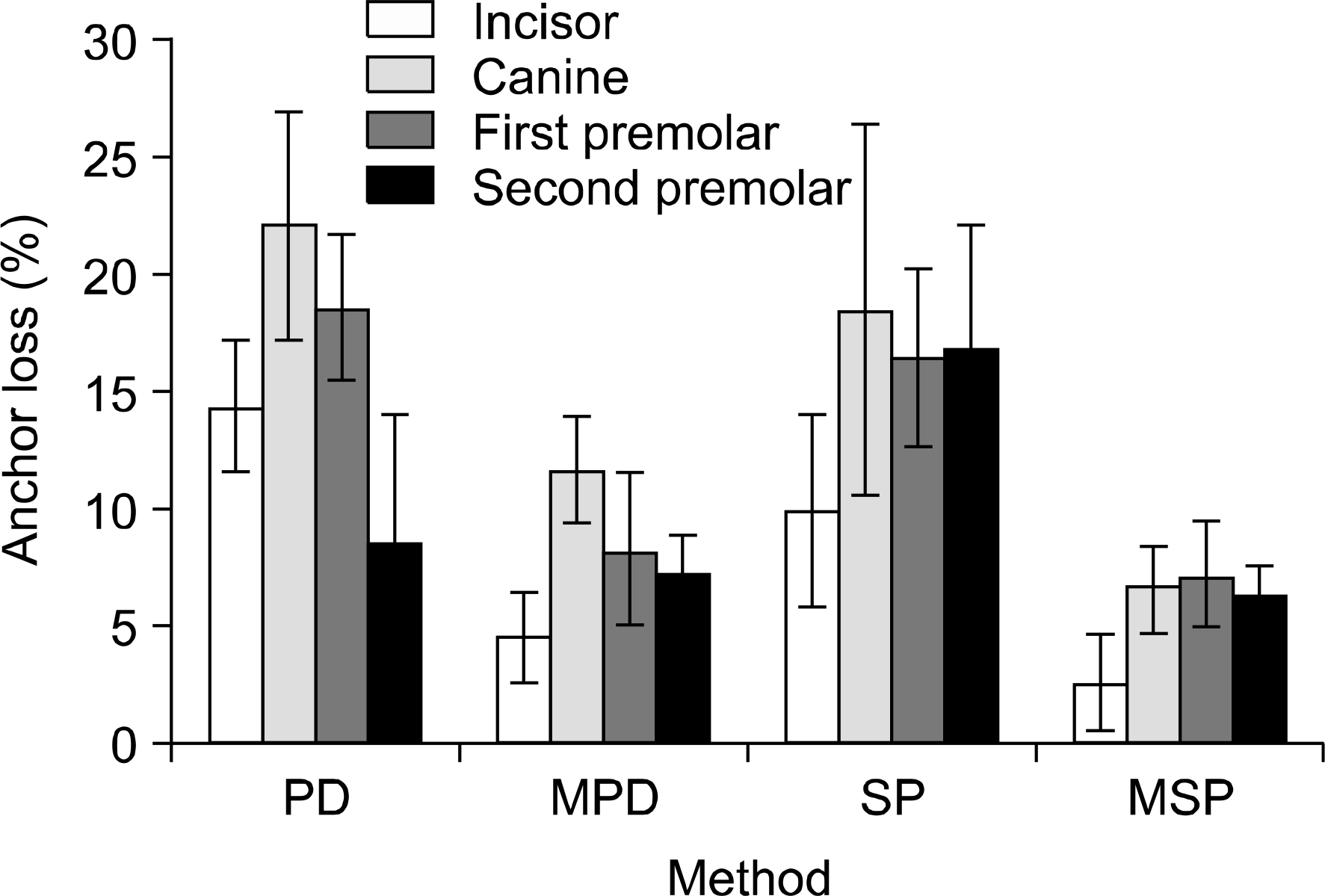
Table 1.
Comparison of linear measurements between 4 groups - anchor part (Mean ± SD) unit; mm
| Axis | Variable | Pendulum appliance | Mini-implant supported pendulum appliance | Open-coil spring | Mini-implant supported open-coil spring |
|---|---|---|---|---|---|
| Central incisor | |||||
| X | |||||
| Incisal tip | -0.38±0.28a | -0.02±0.04a,b | 0.08±0.35b | 0.03±0.02a,b | |
| Root apex | 0.06±0.11a | 0.12±0.06a | 0.10±0.18a | 0.08±0.06a | |
| Y | |||||
| Incisal tip | -0.16±0.12a | -0.12±0.04a | -0.16±0.12a | -0.08±0.03a | |
| Root apex | -0.19±0.14a | -0.08±0.07a | -0.26±0.23a | -0.11±0.06a | |
| Z | |||||
| Incisal tip | 0.44±0.09a | 0.15±0.07b,c,e | 0.34±0.17a,c | 0.08±0.07d,e | |
| Root apex | 0.45±0.06a | 0.25±0.27a,b | 0.33±0.17a,b | 0.09±0.09b | |
| Canine | |||||
| X | |||||
| Cusp tip | 0.09±0.18a | 0.13±0.13a | 0.21±0.48a | 0.10±0.09a | |
| Root apex | -0.26±0.25a.b | 0.06±0.10a,e | -0.49±0.21b,c | 0.30±0.15d,e | |
| Y | |||||
| Cusp tip | -0.17±0.16a | -0.16±0.17a | -0.10±0.08a | -0.10±0.11a | |
| Root apex | -0.65±0.35a | -0.22±0.13a,b | -0.61±0.46a,b | -0.05±0.07b | |
| Z | |||||
| Cusp tip | 0.78±0.32a | 0.41±0.10a,b | 0.72±0.36a | 0.21±0.07b,c | |
| Root apex | 0.23±0.18a | 0.19±0.13a | 0.09±0.09a | 0.17±0.12a | |
| First premolar | |||||
| X | |||||
| Buccal cusp tip | -0.31±0.22a | 0.16±0.06b | 0.10±0.18b | 0.11±0.08b | |
| Root apex | 0.12±0.14a,b | 0.17±0.10a,c | -0.62±0.29d | 0.02±0.19b,c,e | |
| Y | |||||
| Buccal cusp tip | -0.42±0.19a | -0.14±0.10b | -0.16±0.12b | -0.06±0.08b | |
| Root apex | -0.27±0.17a,b | -0.20±0.11a,c | -0.57±0.10d | -0.12±0.07b,c,e | |
| Z | |||||
| Buccal cusp tip | 0.60±0.15a | 0.27±0.13b,c | 0.60±0.19a | 0.23±0.09c,d | |
| Root apex | 0.50±0.26a | 0.18±0.10b | -0.32±0.06c | 0.17±0.11b | |
| Second premolar | |||||
| X | |||||
| Buccal cusp tip | -0.16±0.17a | 0.08±0.11a | -0.12±0.22a | 0.06±0.03a | |
| Root apex | 0.02±0.13a | 0.00±0.14a | -0.05±0.10a | 0.05±0.14a | |
| Y | |||||
| Buccal cusp tip | -0.23±0.21a | -0.02±0.09a | -0.23±0.18a | -0.11±0.12a | |
| Root apex | -0.13±0.04a,b | -0.03±0.03a,c | -0.32±0.15d | -0.00±0.05b,c,e | |
| Z | |||||
| Buccal cusp tip | 0.24±0.18a,b | 0.24±0.07a,c | 0.63±0.27d | 0.21±0.05b,c,e | |
| Root apex | 0.23±0.19a | 0.31±0.24a | 0.25±0.27a | 0.03±0.07a | |
Table 2.
Comparison of tooth displacement between groups - moving part (Mean ± SD) unit; mm
| Axis | Variable | Pendulum appliance | Mini-implant supported pendulum appliance | Open-coil spring | Mini-implant supported open-coil spring |
|---|---|---|---|---|---|
| First molar | |||||
| X | |||||
| Mesiobuccal cusp | -1.28±0.79a | 0.77±0.72b | 0.72±0.21b | 0.79±0.34b | |
| Distobuccal cusp | -0.14±0.34a | 1.29±0.42b | -0.36±0.27a | -0.03±0.30a | |
| Root apex | -0.67±0.19a | -0.61±0.23a | 0.78±0.26b | 0.71±0.47b | |
| Y | |||||
| Mesiobuccal cusp | -1.36±0.19a | -0.97±0.22a | -0.25±0.31b | 0.23±0.10c | |
| Distobuccal cusp | -0.29±0.13a | 0.08±0.36a,b | -0.21±0.32a | 0.42±0.09b,c | |
| Root apex | -1.39±0.10a | -1.09±0.29a | -0.21±0.33b | 0.21±0.17b | |
| Z | |||||
| Mesiobuccal cusp | -2.63±0.31a | -3.06±0.03b | -3.03±0.04b | -3.04±0.02b | |
| Distobuccal cusp | -2.35±0.36a | -2.99±0.04b | -3.00±0.20b | -2.94±0.60b | |
| Root apex | 1.00±0.20a | 0.71±0.65a | -2.04±0.66b | -2.22±0.27b | |
| Second molar | |||||
| X | |||||
| Mesiobuccal cusp | 1.24±0.56a | 1.99±0.18a | -0.18±0.43b | 0.11±0.38b | |
| Distobuccal cusp | 1.08±0.56a | 1.56±0.39a | -0.46±0.10b | -0.27±0.31b | |
| Root apex | -0.60±0.35a,b | -1.00±0.16b,c | -0.27±0.31a,d | -0.26±0.18a | |
| Y | |||||
| Mesiobuccal cusp | -0.41±0.45a | 0.17±0.38a,b | -0.39±0.17a | 0.55±0.11b,c | |
| Distobuccal cusp | 0.81±0.36a | 1.39±0.22b | 0.06±0.17c | 1.06±0.23a,b | |
| Root apex | -0.55±0.36a | -0.41±0.30a | -0.18±0.26a | 0.51±0.89b | |
| Z | |||||
| Mesiobuccal cusp | -2.60±0.20a | -3.02±0.03b | -2.98±0.07b | -2.98±0.08b | |
| Distobuccal cusp | -2.67±0.27a | -2.86±0.19a | -2.90±0.07a | -2.88±0.08a | |
| Root apex | 1.56±0.31a | 2.23±0.41b | -0.05±0.09c | -1.12±0.26d | |
Table 3.
Comparison of tooth displacement between groups - evaluation of molar tipping (Mean ± SD) unit; mm
| Axis | Pendulum appliance | Mini-implant supported pendulum appliance | Open-coil spring | Mini-implant supported open-coil spring | |
|---|---|---|---|---|---|
| First molar | |||||
| Y | DB-MB | 1.07±0.13a | 1.06±0.20a | 0.04±0.15b | 0.18±0.08b |
| Z | R-MB | 3.63±0.15a | 3.77±0.66a | 1.00±0.64b | 0.86±0.26b |
| Second molar | |||||
| Y | DB-MB | 1.22±0.23a | 1.21±0.33a | 0.45±0.05b | 0.51±0.16b |
| Z | R-MB | 4.16±0.46a | 5.25±0.39b | 2.93±0.07c | 1.85±0.25d |
Table 4.
Comparison of anchor loss ratio between four groups (Mean ± SD) unit; %
| Tooth | Pendulum appliance | Mini-implant supported pendulum appliance | Open-coil spring | Mini-implant supported open-coil spring |
|---|---|---|---|---|
| Incisor | 14.40±2.91a | 4.59±1.92b,c | 9.98±4.05a,c | 2.53±2.08b |
| Canine | 22.19±4.86a | 11.75±2.14a,b | 18.55±7.90a | 6.64±1.97b,c |
| 1st premolar | 18.58±3.15a | 8.19±3.17b | 16.57±3.81a | 7.23±2.28b |
| 2nd premolar | 8.53±5.59a,b | 7.22±1.70a | 16.91±5.34b,c | 6.32±1.27a |




 PDF
PDF ePub
ePub Citation
Citation Print
Print


 XML Download
XML Download